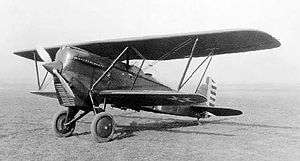Boeing XP-7
The Boeing XP-7 was a prototype United States biplane fighter of the 1920s.
| XP-7 | |
|---|---|
 | |
| Role | Experimental Fighter |
| Manufacturer | Boeing |
| First flight | September 1928[1] |
| Primary user | United States Army Air Corps |
| Number built | 1 |
| Developed from | Boeing PW-9D |
Development and design
The XP-7 started life as the last Boeing Model 15 (PW-9D), serial 28-41. It was then adapted to mount the 600 hp Curtiss V-1570 Conqueror engine. Labelled by Boeing as their Model 93, the XP-7's nose was shorter and deeper than that of the standard PW-9, and the craft was 75 pounds lighter overall.
It first flew in September 1928 and did well, with a 17 mph speed increase over the PW-9. However, despite a proposal to build an additional four P-7s, the design was at the very limits of its capabilities and somewhat outdated even by the time of its first flight. At the end of testing, the Conqueror engine was removed and the aircraft converted back into a PW-9D.[1]
Specifications
Data from [1]
General characteristics
- Crew: 1
- Length: 24 ft 0 in (7.31 m)
- Wingspan: 32 ft 0 in (9.75 m)
- Height: 9 ft 0 in (2.74 m)
- Wing area: 252 sq ft (23.4 m2)
- Empty weight: 2,358 lb (1,070 kg)
- Gross weight: 3,260 lb (1,479 kg)
- Powerplant: 1 × Curtiss V-1570-1 , 600 hp (450 kW)
Performance
- Maximum speed: 167.5 mph (270 km/h, 145.6 kn)
- Cruise speed: 134 mph (216 km/h, 116 kn)
- Range: 250 mi (402 km, 220 nmi)
- Service ceiling: 22,300 ft (6,797 m)
- Rate of climb: 1,408 ft/min (7.2 m/s)
Armament
- 1x .50in machine gun
- 1x .30in machine gun
- 125lb (57kg) bombs
Related lists
References
| Wikimedia Commons has media related to Boeing XP-7. |
- Angelucci, 1987. p. 72.
- Bibliography
- Angelucci, Enzo (1987). The American Fighter from 1917 to the present. New York: Orion Books.
- Lloyd S. Jones, U.S. Fighters (Aero Publishers, Inc., 1975) pp. 32–33 ISBN 0-8168-9200-8